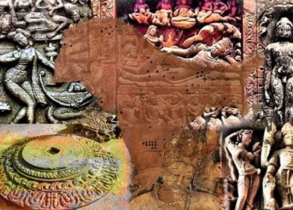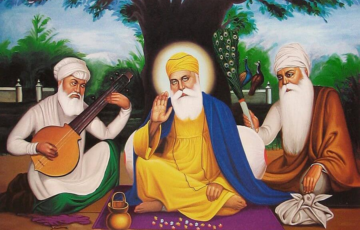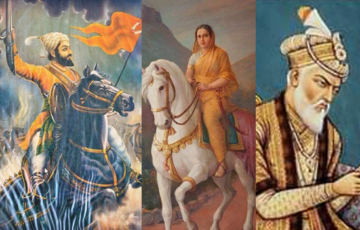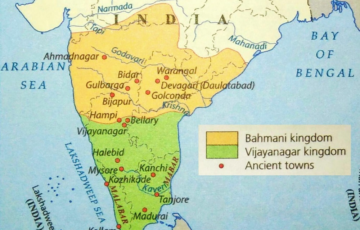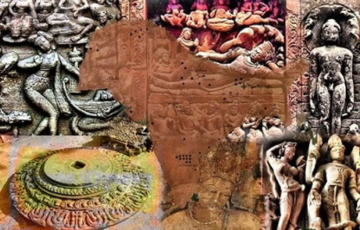INDIA AND WORLD
During the thousand-year period spanning from the eighth to the eighteenth century, significant transformations occurred in both India and the wider world. These changes encompassed social, political, and cultural realms, impacting the lives and ideologies of people across continents. India, with its longstanding trade and cultural ties with regions surrounding the Mediterranean Sea, including the Roman and Persian empires, was not immune to these shifts.
Europe:
Division of the Roman Empire: By the third quarter of the sixth century, the mighty Roman Empire had split into two. The western part, with Rome as its capital, succumbed to invasions by Slavic and Germanic tribes from Russia and Germany, leading to significant upheaval and plundering. These invasions reshaped the demographics, languages, and governance structures across Europe.
- Formation of European Nations: Despite the turmoil caused by invasions, the merging of these tribes with the local population laid the groundwork for many modern European nations. This period marked a significant evolution in European identity and governance.
- Byzantine Empire: The eastern part of the Roman Empire, centered around Byzantium (later Constantinople), persisted as the Byzantine Empire. This empire, encompassing eastern Europe, Turkey, Syria, and North Africa, maintained Roman administrative traditions but diverged from the Catholic Church, instead adhering to the Greek Orthodox Church. It played a crucial role in spreading Christianity to regions like Russia and acted as a cultural bridge between the Greco-Roman and Arab worlds.
- Rise and Fall of Cities: Following the collapse of the Roman Empire in the West, cities in western Europe declined, partly due to the lack of resources like gold for trade with the Orient. This era, often termed the ‘Dark Age,’ witnessed a decline in urban life.
- Agricultural Expansion and Urban Revival: Despite the decline of cities, there was significant agricultural expansion from the sixth to the tenth centuries, laying the groundwork for a resurgence in urban life and foreign trade. Between the twelfth and fourteenth centuries, western Europe experienced a period of prosperity marked by scientific and technological advancements, urban growth, and the establishment of universities, fostering new ideas and contributing to the Renaissance and the emergence of a new European identity.
Growth of Feudalism in Europe:
- Emergence of Feudalism: Following the collapse of the Roman Empire, a new societal structure known as feudalism began to take shape in western Europe. Feudalism, derived from the Latin word “feudum,” referred to a system where powerful chiefs controlled vast land tracts and wielded significant influence over governance.
- Role of Chiefs and Monarchy: The most influential figures in feudal society were the chiefs, who commanded military followings and held sway over territories akin to mini-states. Even the king operated as a powerful feudal chief, albeit with nominal superiority. Over time, attempts were made to strengthen the monarchy and curtail the autonomy of chiefs to mitigate constant internal conflicts.
- Feudal Governance: Feudal government was characterized by a landed aristocracy dominating administrative functions. Chiefs swore loyalty oaths to the king as vassals, in exchange for land grants known as fiefs. Chiefs, in turn, appointed sub-chiefs as vassals and allocated portions of their fiefs to them.
- System of Serfdom: A crucial aspect of feudalism was the system of serfdom, where peasants known as serfs worked the land under the control of lords or masters. Serfs were tied to the land, unable to change professions, migrate, or marry without their lord’s permission. The manor system, where lords lived and governed, was integral to this arrangement.
- Evolution of Military Organization: Feudalism in Europe was closely linked to a militaristic structure. The iconic image of the armored knight on horseback symbolized feudal military prowess. The shift towards cavalry warfare, influenced by Arab tactics, spurred the growth of feudalism by necessitating decentralized military organization.
- Technological Influences: Technological advancements, such as the iron stirrup and improved horse harnesses, facilitated the rise of cavalry warfare, contributing to the consolidation of feudal power structures. These innovations likely originated from East Asia and spread to Europe, aiding in military decentralization.
- Factors Contributing to Feudalism: Political, economic, and military factors all played roles in fostering the growth of feudalism. Despite attempts by stronger governments to centralize power, feudal traditions persisted due to entrenched societal norms and the vested interests of feudal chiefs.
- Influence of the Catholic Church: Alongside feudalism, the medieval period in Europe was shaped by the influence of the Catholic Church. The Church, particularly through the Pope, wielded significant political and moral authority, contributing to the cultural and educational landscape of Europe through the establishment of monastic orders and monasteries.
- Conflict and Reform: Wealthy monasteries sometimes rivaled feudal lords in power, leading to internal discord and conflicts with secular rulers. This tension between the Church and secular authorities would manifest in later movements such as the Renaissance and Reformation, reflecting struggles for power and reform within medieval European society.
The Arabs
- Rise of Islam and Unification: The advent of Islam in the seventh century played a pivotal role in uniting previously warring Arab tribes into a formidable empire. The early caliphs established an expansive Arab empire encompassing territories spanning from Arabia to Spain, including Syria, Iraq, Iran, Egypt, and North Africa.
- Abbasid Dynasty and Baghdad: Amid internal conflicts, the Abbasid dynasty rose to power in the middle of the eighth century, displacing the caliphate in Damascus. They established their capital in Baghdad, claiming lineage from Prophet Muhammad and ruling over a vast and prosperous empire for about 150 years.
- Economic Prosperity and Cultural Flourishing: The Abbasid Empire flourished economically and culturally, commanding crucial trade routes linking the Mediterranean world with India. Arab merchants emerged as prominent traders, fostering a thriving urban environment with magnificent buildings and a high standard of living. The introduction of the gold dinar and silver dirham facilitated trade across the globe.
- Scientific and Intellectual Advancements: The Abbasid caliphs, notably al-Mamun and Harun al-Rashid, fostered an environment conducive to intellectual inquiry and scientific innovation. They established centers of learning, such as the House of Wisdom in Baghdad, where scholars translated and synthesized knowledge from various civilizations, including Greek, Egyptian, Indian, and Chinese.
- Contributions to Science and Technology: Arab scholars made significant contributions to various fields, including mathematics, astronomy, medicine, and geography. They popularized the decimal system, introduced algebra, and developed advanced navigational instruments for sea travel. Arab science flourished, leading to the establishment of renowned libraries and scientific laboratories.
- Cultural Exchange with India: India’s cultural and scientific contributions to the Arab world were notable, particularly in mathematics and medicine. Indian works on astronomy, mathematics, and medicine were translated into Arabic, influencing Arab scholarship. Indian traders and craftsmen were welcomed in Arab lands, facilitating cultural exchange and trade.
- Decline of Arab Science: Despite its zenith, Arab science began to decline after the twelfth century due to political and economic upheavals and increasing orthodoxy. However, scientific advancements continued in Spain until the fourteenth century, contributing to the legacy of Arab science and civilization.
- Intellectual Freedom and International Collaboration: Arab science thrived due to the remarkable degree of intellectual and personal freedom enjoyed by scholars, as well as the patronage extended to them. The Arab world served as a melting pot of diverse cultures and ideas, fostering international collaboration and knowledge exchange.
- Impact on Europe and India: While Arab science influenced European thought and contributed to the Renaissance, its impact on India during this period was limited. The rigid attitudes of the church in Europe stifled scientific inquiry, while conditions in India may have similarly hampered the dissemination of Arab scientific advancements.
Overall, the Arab world during this period was a beacon of scientific, cultural, and intellectual progress, leaving a lasting legacy on global civilization.
Africa:
- Arab Influence and Trade: Arab migrations and mercantile activities along the east coast of Africa intensified, reaching regions like Malindi and Zanzibar. This increased trade brought Africa closer to the Indian Ocean and Middle Eastern commerce. However, Arab trade in Africa involved significant export of slaves alongside commodities like gold and ivory.
- Ethiopian Kingdom and Indian Ocean Trade: Ethiopia, a long-standing powerful kingdom, known as Habshis, participated in Indian Ocean trade routes through Aden to India. Ethiopians, primarily Christians, maintained close ties with the Byzantine Empire, which diminished with the decline of Byzantine influence.
East and Southeast Asia:
- Tang Dynasty’s Golden Age: China experienced a cultural and societal apex during the Tang Dynasty in the eighth and ninth centuries. Tang rulers expanded their authority into Central Asia, particularly Kashgar, facilitating overland trade along the Silk Road.
- Rise and Fall of the Tang and Mongol Conquest: The decline of the Tang Dynasty in the ninth century led to the rise of the Sung Dynasty, which, in turn, succumbed to Mongol conquest in the thirteenth century. Despite the devastation wrought by the Mongols, their disciplined cavalry enabled them to unify north and south China and extend their empire into Korea and Vietnam.
- Southeast Asian Kingdoms: Southeast Asian states, such as the Sailendra and Kambuja empires, flourished independently during this period. The Sailendra dynasty, comprising the Sri Vijaya empire, dominated the region until the tenth century, with extensive trade networks extending to China. The Majapahit empire succeeded Sri Vijaya, further expanding its influence across Southeast Asia until the fourteenth century.
- Cultural and Architectural Achievements: Southeast Asian kingdoms, influenced by Indian civilization, developed distinctive cultures and architectural marvels. Temples like Borobodur in Java and Ankor Wat in Cambodia exemplified their cultural and religious sophistication, with intricate carvings depicting Hindu epics like the Ramayana and Mahabharata.
- Cultural Exchange and Religious Influence: Indian traders and scholars played significant roles in Southeast Asia, fostering cultural exchange and the spread of Buddhism. While Buddhism thrived in Southeast Asia, Indian traders maintained commercial and cultural ties with China and Africa, contributing to the cosmopolitan nature of these regions.
- Religious Freedom and Tolerance: Despite Arab trade and influence, religious freedom and tolerance prevailed in these regions, with diverse cultures coexisting peacefully. The gradual spread of Islam in Indonesia and Malaya occurred after Islam’s consolidation in India, while Buddhism continued to flourish elsewhere.
- Impact of Colonialism: Commercial and cultural connections between India and Southeast Asia endured until colonial powers, such as the Dutch and English, disrupted these ties. Nevertheless, the legacy of cultural exchange and tolerance persisted, shaping the vibrant identities of these regions.
UPSC PREVIOUS YEAR QUESTIONS
1. With reference to Indian history, which of the following is/are the essential elements of the feudal system?
1. A very strong centralized political authority and a very weak provincial or local political authority
2. Emergence of administrative structure based on control and possession of land
Creation of lord-vassal relationship between the feudal lord and his overlord
Select the correct answer using the code given below.
(a) 1 and 2 only
(b) 2 and 3 only
(c) 3 only
(d) 1, 2 and 3
2. Highlight the Central Asian and Greco-Bactrian elements in Gandhara art. (2019)
3. Assess the importance of the accounts of the Chinese and Arab travellers in the reconstruction of the history of India.


